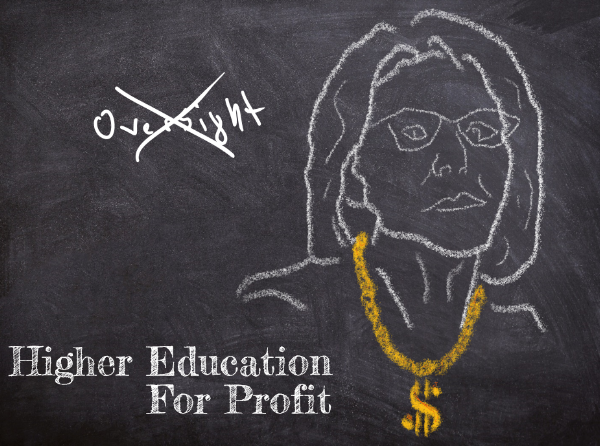Racial Equity, Betsy DeVos and For-Profit Colleges
The New York Times recently released an article detailing how Betsy DeVos dismantled a Department of Education team that investigated fraud and abuse by for-profit colleges. Fraud and abuse in for-profit colleges generally pertain to false advertising meant to increase enrollment. For example, in 2016 DeVry settled a lawsuit for 100 million dollars that alleged it’s advertisements about employment and salaries after graduation misled prospective students. As a high school educator, dismantling this department leads me to several questions: who does this affect the most? How does this relate to K-12 public education? But where to start...
The History
For-profit colleges in the U.S. have been around since colonial times. Originally for-profit schools focused on career training that was not available in early U.S. colleges like Harvard which primarily taught theology, Greek and Latin languages, classical literature, and philosophy. However, from 1890-1972 enrollment in for-profit colleges shrunk to less than 1% of higher education attendance as the U.S. government instituted highly subsidized public institutions (the majority of which only granted access to white middle and upper-class individuals for 100’s of years).
For-profit colleges began a resurgence in 1972 with the reauthorization of the Higher Education Act that increased the amount of government student aid available to for-profit schools. In 1976 the University of Phoenix opened, drastically changing the landscape by utilizing online learning and targeting working-class adults (a group who did not have easy access to higher education in the 1970s). In 1993, the University of Phoenix went public, as the Apollo Group, with booming stock prices demonstrating a for-profit college could be a highly lucrative business. By 2010, for-profit colleges expanded to 12% of higher education attendance and took in roughly 25% of National federal student aid dollars (or roughly 32 billion). After 2010, enrollment in for-profit colleges declined, dropping 40% by 2015, as the Obama administration increased accountability for for-profit institutions threatening to deny federal aid to programs for low graduation rates, making false promises, and encouraging high student debt resulting in defaults. Today, with declining enrollment, several for-profit colleges have closed, and even Apollo Group recently re-privatized.
Demographics of For-Profit Colleges
The majority of students who attend for-profit colleges are students of color, low-income students, military veterans, and/or older students (median age of attendance is around 27). For example, students of color make up 55% of graduate students at for-profit schools and just 30% of graduate students at public schools; and according to a Pell Institute 2015 study, lower-income students of color were 3.5 times more likely to attend a for-profit college than not-for-profit public or private institution. Despite enrolling more students from lower income backgrounds, for-profit colleges actually cost more to attend ($15,130 per year) than public 2-year schools ($3,264 per year) and 4 years schools ($8,893 per year). Interestingly, for-profit colleges also spend more on advertising than on academics according to a United States Senate 2012 report. As such, outcomes are worse at for-profit colleges, with average program completion rates for black students falling to 16% (versus black student completion rates of 39-45% at private not-for-profit and public institutions respectively), additionally, for-profit students default at 4-times the rate of students who attend public 2-year colleges, and even after controlling for socioeconomic status students who graduate from for-profit colleges are less likely to be employed after graduation than peers at other schools. Furthermore, their earnings are, on average, lower. At its core for-profit college issues are equity issues.
High Expectations and Racial Equity
We know for-profit schools cost more for students and prepare them for less. We know that there are a disproportionate number of students of color and students from lower-income families attending for-profit colleges. And we know attendance at for-profit colleges is declining. Therefore, we know who DeVos easing oversight on for-profit colleges effects most: students of color, poorer students, poorer students of color, and the investors of companies like the Apollo Group. But a bigger question is: why is there an appetite for for-profit colleges amongst students of color and poorer students to begin with? Yes, there is fraudulent advertising targeting these groups that will most likely increase now, but there are other factors at play as well.
Advocates of for-profit colleges argue the increase in for-profit schools over the last two decades suggests America’s nonprofit colleges are failing to fully meet the people’s needs; however, is it just nonprofit colleges failing to meet people's needs, or is it the failure of access to quality k-12 public education which prepares students to see through false advertising; to prepare students of color for more than the school and prison nexus; and to prepare students to gain access to what were primarily wealthy white institutions for 100’s of years. It’s possible the for-profit colleges' bubble may have burst, and DeVos’s easing of oversight may not be enough to bring the bubble back; regardless, this decision leads one to question what other levers of positive change regarding equity in k-12 education are being minimized by the Department of Education.
Ian McLaughlin
